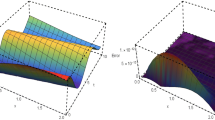Abstract
The partial differential equation for unsteady-state diffusion, adsorption and a first-order reaction in a catalyst is often approximated to ordinary differential equations for reduced computational loads. Very high-order models obtained by the continued fraction expansion method are accurate for a wide range of the Thiele modulus and the changing frequency of surface concentration. In addition, they are numerically well-conditioned. However, due to their high dimensionalities, they will not have merits over other low-order models. Here, high-order models based on the continued fraction expansion method are shown to be used to obtain various practical models. With the Taylor series obtained from high-order models, Pade approximations are easily obtained regardless of the Thiele modulus and the shape of catalyst. Low-order models by applying the balanced truncation method to a high-order model can also be obtained, providing better approximations than the well-known Pade models.
Similar content being viewed by others
References
D. H. Kim, AIChE J., 54, 2423 (2008).
T. L. P. Dantas, F.M. T. Luna, I. J. Silva Jr., D.C. S. de Azevedo, C.A. Grande, A. E. Rodrigues and R. F. P.M. Moreira, Chem. Eng. J., 169, 11 (2011).
E. Glueckauf, Trans. Faraday Soc., 51, 1540 (1955).
J. Lee and D. H. Kim, Chem. Eng. Sci., 53, 1209 (1998).
P. Cruz, F.D. Magalhaes and A. Mendes, Chem. Eng. Sci., 61, 3519 (2006).
A. Patton, B.D. Crittenden and S. P. Perera, Chem. Eng. Res. Design, 82, 999 (2004).
D. H. Kim, AIChE J., 55, 834 (2009).
J. Lee and D. H. Kim, Chem. Eng. J., 173, 644 (2011).
D. H. Kim and J. Lee, Korean J. Chem. Eng., 29, 42 (2012).
E. Kreyszig, Advanced engineering mathematics, Wiley, New York (1999).
M. Abramowitz and I. A. Stegun, Handbook of mathematical functions, Dover Pub., New York (1972).
C. F. Chen and L. S. Shieh, IEEE Trans. Circuit Theory, 16, 197 (1969).
J. Lee and T. F. Edgar, Comp. Chem. Eng., 28, 479 (2004).
M. Green and D. J. N. Limebeer, Linear robust control, Prentice-Hall, New Jersey (1995).
MATLAB, The MathWorks, Inc.
T. Kailath, Linear Systems, Prentice-Hall, New Jersey (1980).
Author information
Authors and Affiliations
Corresponding author
Rights and permissions
About this article
Cite this article
Cho, W., Lee, J. Applications of high-order approximate models for unsteady-state diffusion and reaction in a catalyst. Korean J. Chem. Eng. 30, 580–586 (2013). https://doi.org/10.1007/s11814-012-0188-8
Received:
Accepted:
Published:
Issue Date:
DOI: https://doi.org/10.1007/s11814-012-0188-8




